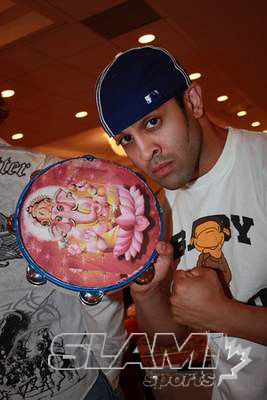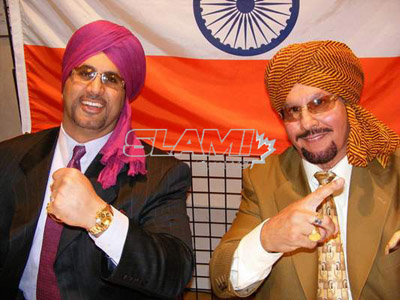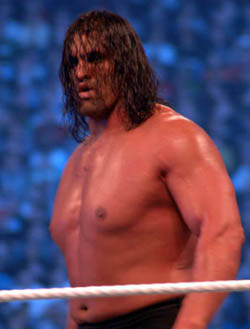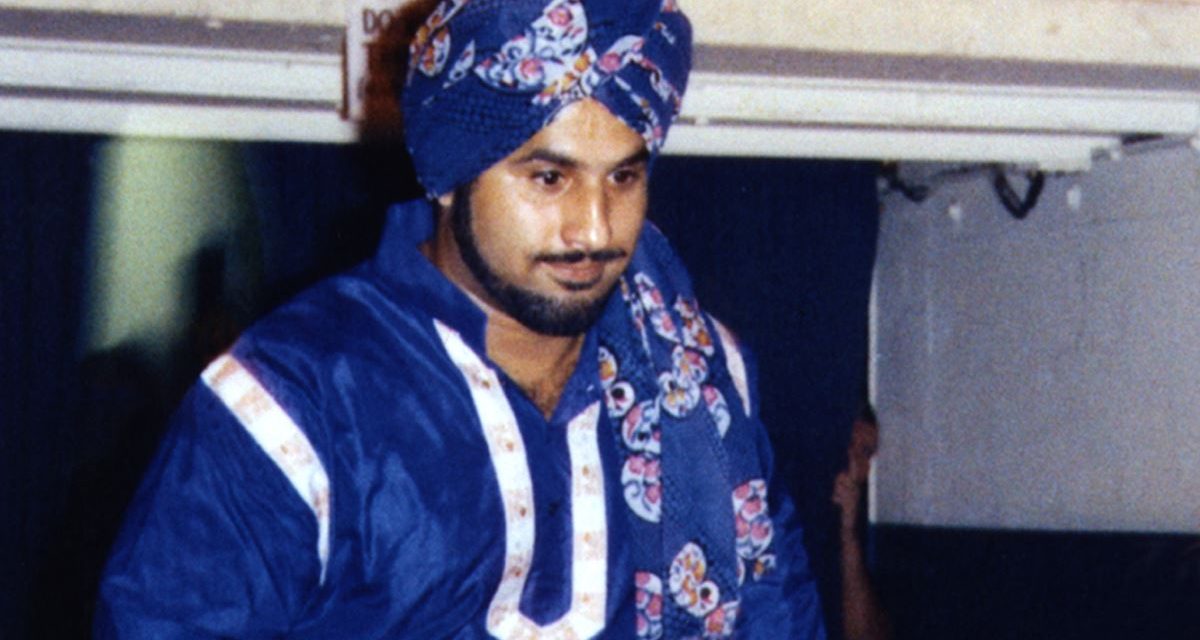Being a minority in the wrestling business is not easy; just like any other walk of life, what’s different is often mistreated. But that was never the case for Sonjay Dutt.
Dutt has always been proud to be a minority, because it’s what makes him unique. He says he’ll never forget where he came from and his Indian heritage is very important to him, as evident by his ring name, which was taken from a famous Bollywood actor, but he changed it from Sanjay to Sonjay, so the American audience would be able to pronounce it better.

Sonjay Dutt poses at the Legends of the Ring convention in May 2010 in New Jersey. Photo by Christine Coons
“Sometimes promoters don’t take full advantage of someone’s ethnic background,” he said. “I’m Indian, with Indian parents and I actually speak Hindi, but they (TNA) never capitalized on that when it came to possible tours of India or to reach out to the huge Indian audience even more so.”
Despite his Indian pride, Dutt never looked at his background as something that provided him with specific advantages. Nor did he see it as something that put him at disadvantages. Dutt says if anything, the promoter is the one who should be taking advantage of it.
“Sometimes promoters don’t take the right advantage of someone’s ethnicity and make a joke out of it,” Dutt said. “I could have easily come out in a turban and said that I was a cab driver or worked at a 7-11. But that’s easy heat; it’s cheap heat. And I didn’t want to disrespect my family or my background. Was I not given the same advantages a white wrestler was given because I was Indian? I’d like to think the answer is no.”
Times have seemingly changed over the last 20 plus years, and considering Dutt’s recent tales from the turnbuckle, they may have even improved. The wrestling business has not always been kind to former WWE performer Tiger Ali Singh, who was born in Canada to South Asian parents, and follows the Sikh religion.
Singh says he was discriminated against more times than he cares to count because of his ethnicity. But rather than retaliate, he always turned the other cheek, because negativity is not something he ever wanted to be a part of.

Tiger Jeet Singh and Tiger Ali Singh at the Legends of the Ring convention in May 2010 in New Jersey. Photo by Michael Coons
“I have been discriminated against. But I try not to let anyone else’s misery get me down,” Singh said. “What I’ve learned in life is that miserable people don’t like to see others happy. And when they find anyone exuding happiness, they then try to make them unhappy by bullying, to have them feel as bad as they’re feeling. I simply feel very sorry for these types of individuals, because unbeknownst to them, the only people they’re really hurting are themselves. Only minorities can tell you about discrimination. And when I say minorities, I’m referring to any individual who is outnumbered by sex, religion, ethnicity.”
Singh usually wore a turban as part of his character in the WWE, but he refused to ever wear it during a match or use it as a prop, due to his personal beliefs. He was often ridiculed for wearing the turban, but never let it get him down, despite all the emotional scars.
“Gerald Brisco came up to me and asked if I had a problem not only wrestling in a suit with my turban on, but to have Steve Blackman rip my turban off during the match. I thought it would be a public defamation of the Sikh religion,” Singh said. “In wrestling, if you ever do anything against management, they’ll either fire you, or make your life a living hell. But I never quit, no matter what I was given to work with. I always made the most of it. They (WWE) tried to stereotype me, but I turned it around and kept saying, ‘How low will an American go?’ I manipulated the character and threw it back in their face.”
Dutt wore a turban a couple years ago as well when he did the guru character in TNA, but never did it to offend anybody and no line was ever crossed like it was with Singh in the ’90s. In fact, other than the turban and the tambourine with Ganesh on it, Dutt didn’t consider the character any kind of Indian stereotype at all.
“When they gave me this guru character in TNA, I just ran with it,” Dutt said. “Jeff (Jarrett) came up to me and said he wanted me to be a know-it-all. The word guru means teacher, and I was just acting the way I thought the character should act. Nothing I did was racially offensive and if I myself didn’t take offense to it, I don’t see any reason why anyone else would. I always tried to portray myself in a positive light and tried not to adhere to the negative. They could have had any white man play that character. I don’t think they chose me just because I’m Indian. I was essentially supposed to be a con man and that’s all it was.”
The popularity of the South Asian market is probably the biggest it’s ever been. But that wasn’t always the case.
South Asians have never really been showcased on an international platform until recently. Not just in sports, but music and movies as well. However, thanks to grapplers like Dutt and Singh plying their craft on major television networks, the South Asian community now have as much a reason to celebrate as anyone else.
Wrestling-wise, South Asia has a rich history, particularly in the amateur field. The Great Gama (Ghulam Muhammad) was a Punjabi superstar in the first decades of the 1900, winning the championship of India in 1901 at the age of 19, and was reportedly undefeated his entire career, wrestling in over 5,000 matches.
In the 1960’s Singh’s father Tiger Jeet Singh boosted India’s popularity by competing all over the world. Tiger Jeet competed against a who’s who in the wrestling business, and was a major headliner in Japan. He continues to wrestle on occasion overseas, and recently had a school named after him in his adopted hometown of Milton, Ontario, for his humanitarian works.

Look out, it’s the Great Khali! Photo by Mike Mastrandrea
A frequent opponent of Singh’s in the 1970s was The Sheik (Ed Farhat), who was billed (truthfully) from Lebanon. But Farhat’s nephew Sabu (Terry Brunk) was usually announced as being from Bombay, India.
India’s international fame continued to grow with the rising popularity of Bollywood music and movies and the Oscar-winning performances in Slumdog Millionaire. Only a few years earlier, Sonjay Dutt exploded onto the scene and began to showcase his talents as one of the best high-flyers of this generation, as his ring skills would allow him to soar to fame in TNA.
And then of course came India’s biggest claim to fame in pro wrestling, as current WWE performer The Great Khali became the first Indian-born wrestler in history to win the World Heavyweight Championship. That’s not to say his portrayal has been completely sporting.
Take the April 11, 2008 edition of Smackdown as an example, which WWE.com listed among the greatest moments in the show’s history. Here’s their version of it: “The Great Khali and his entourage made a special Punjabi Peace Offering to Big Show, offering presents that included a goat, a chicken and Ganges River water, a bottle of Indian refreshment. Big Show then expressed how he felt by knocking The Punjabi Playboy out with one punch.” To Hindus, having the Ganges River water portrayed less than pure was as offensive to that faith as it was to Christians when Raven crucified Sandman in ECW.
Singh says that promoters love the idea of having minorities in their companies, because it presents them with the opportunity to appeal to all kinds of international markets.
“There’s a reason why they (promoters) have representatives of different cultures in the company. There’s a reason why they have African-Americans, Asian-Americans and Indians,” Singh said. “Because the promoter wants to penetrate those markets.”
Although Singh and Dutt may have different opinions on what is considered a stereotype, neither one of them have any regrets about the decisions they’ve made and both of them are proud to be minorities and wouldn’t have it any other way.
RELATED LINK
SONJAY DUTT STORIES
- March 29, 2018: Future uncertain for Sonjay Dutt
- Aug 16, 2017: X Division continues to set GFW apart
- June 1, 2011: Tigerfest draws Dutt back
- June 9, 2005: Sonjay Dutt a Cup playa


